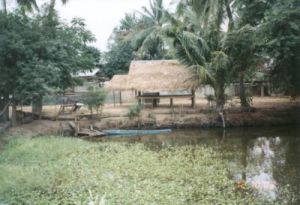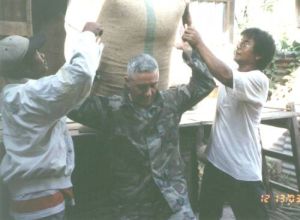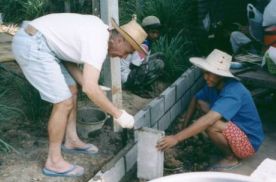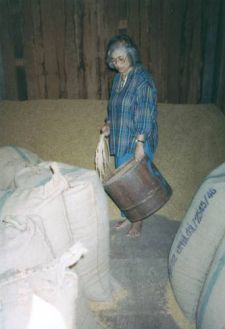Steve and Jemjahn go to Thailand, 2003
5. Jem's Old Home in the Village
10. Impressions of the Village
22. Thai People, My Impressions
6. New rice storage house
Over the years Jem had sent what I considered some serious amounts of money back home for her “projects.” We’d talk about it, sometimes argue about it, but I understood that the relatively small amount of money we’d send to her parents, siblings and old friends went a lot further than it would in America. A few hundred here, a few thousand there, the money improved their lives in ways otherwise impossible.
Not simply sending money as an "allowance," Jem has provided seeding for buying cows, pigs, chickens or ducks, and small plots of land to raise them. In some cases, these projects have been life-altering, helping to get a despairing head of household back on his feet, putting food on his family's table, or preventing the confiscation of his house or land. Because the money is sent as a loan (though we never expect to be repaid, and rarely have been), there's no loss of pride or increase in dependency by the recipient of Jem's kindness. Jem's loans are interest-free, loans that otherwise would have to be made with loan sharks at exorbitant rates with land as collateral.
Jem's
projects have brought life-saving aid to many families, and deep
happiness and meaning to her. A win-win situation for all.

We saw some examples in the back yard. The fish pond, created when we married in 1969, was drained and dredged last year, then refilled and restocked with golden tilapia that jump onto your hook. Ducks and geese were in the backyard pens, and chickens walked around freely. The vegetable garden was impressive. Almost all of this was funded, at least initially, by Jem.
Some of the projects are small. The uphill neighbors wouldn’t control their water runoff (“Can we talk to the water, will it listen to us?”), so having apparently studied Robert Frost, Jem had a wall built between the two houses. An ugly concrete block wall, but the neighbor's water, nor anything else about her, was no longer a problem.
And then there was the rice storage house.
That was another part of my “dowry” when we married, something I probably wouldn’t have been concerned with had I married a nice Jewish girl as my parents hoped.
Every rural Thai family needs a rice storage house the same way every rural American family needs a … a …. pickup truck?
No, just as a pickup is more than a truck, a rice storage house is more than just a place to store rice.
That's because rice is more than food. Rice can always be exchanged, whether for goods or cash. Rice is like money in the bank.
A rice farmer needs a storage house to store his annual harvest, and behind virtually every house in the village stands a rice storage house.
They have
a common design. The house stands on six concrete pillars – two front,
two back, two middle -- on which lie 6" x 6" sills that provide the base
for the house. The floor is about four feet off the ground. That
protects the rice from the frequent flooding, and allows a 100kg sack of
rice to be transferred from shoulders to deck, and the reverse, from
deck to shoulders.
provide the base
for the house. The floor is about four feet off the ground. That
protects the rice from the frequent flooding, and allows a 100kg sack of
rice to be transferred from shoulders to deck, and the reverse, from
deck to shoulders.
The storage area is about 7 feet wide, 10 feet long, with walls about 8 feet high. That seems a couple feet higher than seems necessary, but what the heck do I know about rice storage houses.
The new house we built was made entirely of wood except for the corrugated, galvanized tin roof. The house had been standing at another location, bought, disassembled and brought to the back yard. Wood that looked weak or warped was replaced. Maybe my imagination, but that seemed to increase the carpenters’ care, their extra effort for working with quality material. I saw a lot of attention to detail in areas that could have been overlooked, as setting each and every nail in the floor below the surface (very time consuming), and tensioning each floorboard before nailing it in to ensure no cracks between them.
This is one rice storage house that should last for decades. If it stays dry and doesn’t burn down it’ll last forever, as every wooden part of it is replaceable.
In front of the house the floor joists extended to hold a small deck, needed for sacks being picked up or dropped off. Two of the boards of the deck were weather worn, badly enough, I thought, to be a safety hazard. Jem and I went to a neighbor down the street who, elderly and no longer a rice farmer, had torn down their rice storage house. We bought a couple of planks of strong heavy lumber, along with a set of steps. The two planks fit without any trimming, and the steps needed only a couple of concrete blocks to be at just the right height.
Jem wanted a roof coming off the back end of the house to provide shade for kitchen work done outdoors. Built of corrugated tin, the roof was too small to catch much rainfall, but too large to let all its runoff splash on the ground below. We added a small concrete wall to channel the water.
Building the wall introduced me to the Thai concrete block, considerably
thinner than the familiar American version. The American block, we know,
is 8 x 8 x16 inches. The Thai block is 2 ˝ x 8 x 16 inches (my
measurements rounded up from the metric). So where you don’t need thick,
strong walls, the thin Thai block is just right. Where you do need
thick, strong walls, you just double or triple the Thai block to equal
our standard American one.
the familiar American version. The American block, we know,
is 8 x 8 x16 inches. The Thai block is 2 ˝ x 8 x 16 inches (my
measurements rounded up from the metric). So where you don’t need thick,
strong walls, the thin Thai block is just right. Where you do need
thick, strong walls, you just double or triple the Thai block to equal
our standard American one.
I saw houses under construction with the thin concrete blocks used as sheathing, a base onto which stucco or cement is added. It seems to work, though I hope Thailand isn’t in an earthquake zone.
The
final step in building the storage house was to seal the floor and wall
joints. I didn’t understand why – how
much
rice could escape the burlap sacks anyway? But I soon learned that while
rice is always carried to the storage house in sacks, the sacks are then
usually emptied onto the floor. Jem says this is to prevent mold that
sometimes occurs when left in sacks.
didn’t understand why – how
much
rice could escape the burlap sacks anyway? But I soon learned that while
rice is always carried to the storage house in sacks, the sacks are then
usually emptied onto the floor. Jem says this is to prevent mold that
sometimes occurs when left in sacks.
Dang, the 69-year-old neighbor, as agile as a ten-year-old, caulked the floor-wall joints with the traditional mixture of cow manure and mud. A few days later, after it had dried, we loaded two sacks of rice, the first into the new house. No leaks.
Why did we need a second rice storage house anyway? Wasn’t the first one, pictured at right with Jem in it, still standing?
Indeed, it was, but it wasn’t Jem’s rice storage house. Another of her childhood dreams (or demons), she’d wanted a rice storage house of her own all her life, and now, at 57, she finally had one. The fact that it’s twelve thousand miles away is beside the point: she has a rice storage house, there’s rice in it, therefore she won’t go hungry.
A more practical reason is that now Jem has a place to store her own rice without mixing it with her sister's. Jem still owns a few acres of rice fields, inherited from her father, which she rents to villagers who don’t have enough land of their own. They farm Jem’s fields and give her a portion of the harvest. Jem intends to use her rice as a kind of village food bank, lending to friends and family in lean years, getting repaid (at no interest) in fat years.
I helped in some stages of the building of the rice storage house, but mostly stayed out of the way. All the carpenters were amateurs except the one who laid out the foundation. His was a particularly tricky job, ensuring the concrete posts were in the right place for the beams, already cut and drilled for the concrete posts in the original location. The carpenters were rice farmers, neighbors, friends, but it was clear this was not the first rice storage house they’d worked on. I’ll bet about every male in the village knows how to build a rice storage house, just as on the old American prairie every farmer knew how to build a sod house or root cellar for his family.
The trip had few regrets for me, but one was that I didn’t bring over a couple of quality hammers and a nail set, maybe a good hand saw and level. Not for me to use, but for the village carpenters, and to leave with them. There was a whole lot of hammering involved. Though my arm would quickly go numb and my palm blistered badly (rather embarrassing on both counts), the other men worked tirelessly. Their hammers were dreadful: unbalanced, one with an uncomfortable rectangular handle, all of them too light. If only I’d brought over a couple of Estwing or Stanley hammers. If only their nail set wasn't the edge of the head of a large nail.
Considering their meager tools, they did a wonderful job. In turn, we fed them well and paid them fairly. No one seemed to be in charge, yet no one seemed to be without something to do. A fine crew.
next: Rice = Money